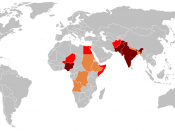BIODIVERSITY ESSAY & CASE STUDY
In this world, there are over 12,000 diseases caused by either bacteria or viruses, and most of them are yet to be discovered. One of the dreadful diseases revealed is polio (which is shortened for poliomyelitis) (Ballard). The polio virus enters the body through the mouth, multiplies in the throat and intestine, and spreads through the blood to the central nervous system. Thus, the virus attacks the CNS, which can lead to paralysis. The paralysis would start with the legs, and would be visible due to the atrophy, and the muscles wasting away due to the lack of use (Hecht). Many have spent their whole life in iron lungs due to paralysis in the chest muscles (Ballard). There are three types of polio: mild, non paralytic and paralytic (Hecht). Only 1% of all polio patients develop paralytic polio (Hecht). In 1947, as Jonas Salk searched for a vaccination, he came upon the conclusion that a chemical called formaldehyde can eliminate the virus (Ballard).
Another scientist named Albert Sabin desired to weaken the virus, instead of killing it (Ballard). Thus, this lead to the invention of oral vaccines that people can swallow (Ballard). A severe disease called post-polio syndrome, which is an illness of the nervous system develops, and can appear 15-50 years after a patient has been affected by polio (Hecht). People and children can contract polio due to a variety of factors, which are present in several third world countries. It still remains to be an underlying health problem in many developing countries (Ballard).
The following is a case study about the several societal and political factors that are affecting Pakistan's polio eradication program. Pakistan is one of the four countries (along with Nigeria, India, and Afghanistan) in which polio has remained endemic since...


